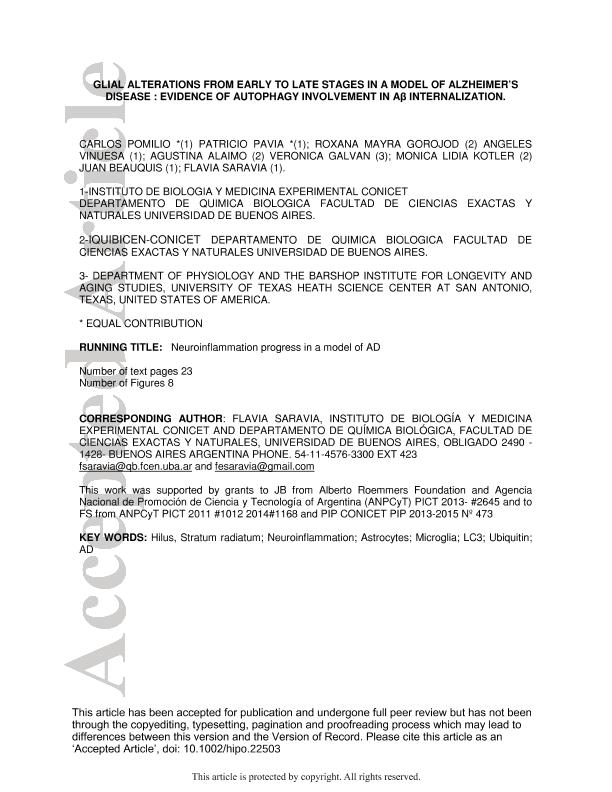Artículo
Glial alterations from early to late stages in a model of Alzheimer´s disease: evidence of autophagy involvement in Aβ internalization
Pomilio, Carlos Javier ; Pavía, Patricio Roberto; Gorojod, Roxana Mayra
; Pavía, Patricio Roberto; Gorojod, Roxana Mayra ; Vinuesa, María Angeles
; Vinuesa, María Angeles ; Alaimo, Agustina
; Alaimo, Agustina ; Galván, María Verónica
; Galván, María Verónica ; Kotler, Monica Lidia
; Kotler, Monica Lidia ; Beauquis, Juan
; Beauquis, Juan ; Saravia, Flavia Eugenia
; Saravia, Flavia Eugenia
 ; Pavía, Patricio Roberto; Gorojod, Roxana Mayra
; Pavía, Patricio Roberto; Gorojod, Roxana Mayra ; Vinuesa, María Angeles
; Vinuesa, María Angeles ; Alaimo, Agustina
; Alaimo, Agustina ; Galván, María Verónica
; Galván, María Verónica ; Kotler, Monica Lidia
; Kotler, Monica Lidia ; Beauquis, Juan
; Beauquis, Juan ; Saravia, Flavia Eugenia
; Saravia, Flavia Eugenia
Fecha de publicación:
04/09/2015
Editorial:
Wiley
Revista:
Hippocampus
ISSN:
1050-9631
e-ISSN:
1098-1063
Idioma:
Inglés
Tipo de recurso:
Artículo publicado
Clasificación temática:
Resumen
Alzheimer's disease (AD) is a progressive neurodegenerative disease without effective therapy. Brain amyloid deposits are classical histopathological hallmarks that generate an inflammatory reaction affecting neuronal and glial function. The identification of early cell responses and of brain areas involved could help to design new successful treatments. Hence, we studied early alterations of hippocampal glia and their progression during the neuropathology in PDAPP-J20 transgenic mice, AD model, at 3, 9, and 15 months (m) of age. At 3 m, before deposits formation, microglial Iba1+ cells from transgenic mice already exhibited signs of activation and larger soma size in the hilus, alterations appearing later on stratum radiatum. Iba1 immunohistochemistry revealed increased cell density and immunoreactive area in PDAPP mice from 9 m onward selectively in the hilus, in coincidence with prominent amyloid Congo red + deposition. At pre-plaque stages, GFAP+ astroglia showed density alterations while, at an advanced age, the presence of deposits was associated with important glial volume changes and apparently being intimately involved in amyloid degradation. Astrocytes around plaques were strongly labeled for LC3 until 15 m in Tg mice, suggestive of increased autophagic flux. Moreover, β-Amyloid fibrils internalization by astrocytes in in vitro conditions was dependent on autophagy. Co-localization of Iba1 with ubiquitin or p62 was exclusively found in microglia contacting deposits from 9 m onward, suggesting torpid autophagy. Our work characterizes glial changes at early stages of the disease in PDAPP-J20 mice, focusing on the hilus as an especially susceptible hippocampal subfield, and provides evidence that glial autophagy could play a role in amyloid processing at advanced stages
Archivos asociados
Licencia
Identificadores
Colecciones
Articulos(IBYME)
Articulos de INST.DE BIOLOGIA Y MEDICINA EXPERIMENTAL (I)
Articulos de INST.DE BIOLOGIA Y MEDICINA EXPERIMENTAL (I)
Citación
Pomilio, Carlos Javier; Pavía, Patricio Roberto; Gorojod, Roxana Mayra; Vinuesa, María Angeles; Alaimo, Agustina; et al.; Glial alterations from early to late stages in a model of Alzheimer´s disease: evidence of autophagy involvement in Aβ internalization; Wiley; Hippocampus; 26; 2; 4-9-2015; 194-210
Compartir
Altmétricas



